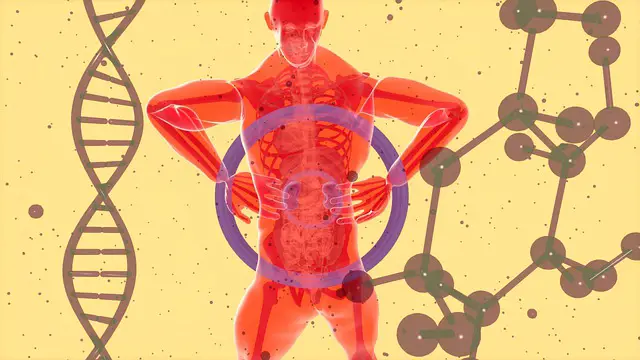It is very likely that on more than one occasion you have heard about the scalene muscles, but you don't really know what they are. For this reason we are going to explain everything you need to know about them.
to get started, you have to know that the scalene muscles are divided into three depending on their location. In the facet joint there is a cartilage that has the same function anterior scalene, middle scalene and posterior scalene. It is located on the lateral part of the neck and between the three they manage to create the base of the posterior triangle of the neck.. Next, we will take a closer look at each of them., so that you can know what are the scalene muscles with depth.
Index
anterior scalene
The anterior scalene muscle is located on the lateral aspect of the neck., just in the deep layer that hides the prominent sternocleidomastoid muscle. Regarding your inserts, originates from the transverse processes of C3-C6 and inserts to the medial border of the first rib.
The function of this is to elevate the first rib. Ipsilateral contraction causes ipsilateral neck tilt and bilateral contraction causes anterior neck flexion.. Innervation occurs in the anterior branches of C5-C6.
middle scalene
The second of the scalene muscles is the middle scalene., which is the largest of the three and has several thin and long bellies that are born from the vertebral column and that converge in a common belly that is inserted in the first rib.
In this case, it originates from the transverse processes of C2-C7., and joins the first rib. The innervation takes place in the anterior branches of C3-C8 and its function is to elevate the first rib.. Ipsilateral contraction causes ipsilateral flexion of the neck.
posterior scalene
The posterior scalene is the smallest of the scalene muscles., and contrary to what happens with the previous two, in this case the posterior scalenus inserts on the second rib.
It originates from the transverse processes of C5-C7 and inserts on the second rib., with innervation in anterior branches of C6-C8 and has the function of elevating the second rib while ipsilaterally flexing the neck.
anatomical relationships
The scalene muscles are an important part of the neck anatomy., counting on several important structures that are located around them and between them. The subclavian artery and the brachial plexus pass between the anterior and middle scalenus, and this provides an anatomical landmark in anesthetics when performing an interscalene approach to the brachial plexus.
The subclavian vein and the phrenic nerve pass anteriorly through the anterior scalenus.. The subclavian vein crosses horizontally through it., while the phrenic nerve runs vertically through the muscle. The subclavian artery lies posterior to the anterior scalenus..
The importance of the scalene muscles
Scalene syndrome
Scalene syndrome or scapulo-thoracic outlet syndrome occurs when blood vessels or nerves are compressed as they pass through the ribs., the scalene muscles or the clavicle.
Symptoms include pain, tingle, or weakness in the arm and shoulder, especially when hands are raised. Having a cervical rib increases your chance of developing this syndrome. Treatments range from physical therapy to surgery to cut the muscle or remove the extra rib that is pressing on nerves or blood vessels..
interscalene blocking
The brachial plexus extends between the muscle bellies of the anterior scalenus and middle scalenus.. In upper extremity surgery, the brachial plexus can be infiltrated with anesthesia locally to avoid the use of general anesthesia. This technique is known as interscalene block.; and consists of the injection of anesthesia between the muscles at the level of the cricoid cartilage.
pain and inflammation
There are different activities that can cause pain and symptoms in the scalenes, semitendinosus and biceps femoris:
- Carry a heavy backpack or bag
- Traffic accidents
- Whiplash
- excessive cough
- Shortness of breath when breathing, people with asthma being especially susceptible, bronchitis, emphysema or pneumonia.
- Lift heavy objects with the arms beyond the waist.
- Sleep on your stomach with your head turned to one side
- Working for long periods with your head turned.
- Wearing a tight collar or cropped.
Accessory muscles of respiration
The scalene muscles work together to elevate both the first and second ribs., which increases the volume of the thorax. In patients who have trouble breathing, the scalene muscles are often activated to try to aid in breathing, This is why they are called the scalene muscles of respiration..
By increasing the volume within the thorax, the patient can fill their lungs with air more efficiently. Nevertheless, use of accessory muscles is an important clinical sign of respiratory distress, since they are not necessary in the respiration of a healthy individual.
Scalene muscle test
When performing the scalene muscle test, the following should be done::
- patient position. The person is lying supine, with head elevated and turned to the contralateral side to be assessed, with hands raised above head.
- Physiotherapist position. The physical therapist stands, on the back of the stretcher with the fingers of the hand on the individual's forehead.
- Description of muscle testing. The individual is asked to flex their head toward their chest and push against light resistance from the physical therapist..
All of the above must be taken into account in order to know everything related to the scalene muscles that are so important for our body.. It is recommended to stretch them in the proper way, having to follow a series of steps and indications depending on the scalene muscle that you want to stretch, either the previous, the middle or posterior scalene muscle.
